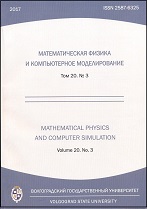|
This article is cited in 3 scientific papers (total in 3 papers)
Modeling, informatics and management
Determination of the boundaries of flooded zones based on hydrodynamic modeling
T. A. Dyakonovaa, V. V. Krivkob, E. O. Agafonnikovaa, A. Yu. Klikunovaa, E. V. Sokolovskiyb, E. S. Savina
a Volgograd State University
b Vitebsk State University named after P. M. Masherov
Abstract:
The paper discusses the problem of determining the boundaries of flooding zones, minor flooding of territories. The paper describes a technique for constructing cadastral maps of flooded zones for various values of the estimated availability of water levels, which is based on hydrodynamic and geoinformation modeling. For creating digital elevation models (DEM) of the conformation, we use spatial data obtained from a large number of sources. We have applied the described technique to construct cadastral maps for a number of settlements in Volgograd region of the Russian Federation. As a result, we get a set of xml-files prepared for registration with the Federal Agency for State Registration, Cadastre and Cartography. For the Republic of Belarus, the problem of flooding of territories is also urgent. The floodplain areas of the Pripyat River are most prone to flooding. We have built a DEM for the area in the vicinity of Petrikov city and carried out hydrodynamic modeling. As a result, the inundation maps have been obtained. The method proposed in this work is based on a mathematical model of shallow water in a single-layer approximation. This model is successfully applied in simulation of flooding for territories by flood waters. Solving the problem of determining the boundaries of flooding zones requires transition to a two-layer shallow water model that takes into account the interaction of surface and ground waters.
Keywords:
cadastral map, numerical simulation, flood zones, shallow water model, digital elevation model.
Received: 03.06.2020
Citation:
T. A. Dyakonova, V. V. Krivko, E. O. Agafonnikova, A. Yu. Klikunova, E. V. Sokolovskiy, E. S. Savin, “Determination of the boundaries of flooded zones based on hydrodynamic modeling”, Mathematical Physics and Computer Simulation, 23:3 (2020), 12–22
Linking options:
https://www.mathnet.ru/eng/vvgum285 https://www.mathnet.ru/eng/vvgum/v23/i3/p12
|

| Statistics & downloads: |
| Abstract page: | 77 | | Full-text PDF : | 40 |
|




 Contact us:
Contact us: Terms of Use
Terms of Use
 Registration to the website
Registration to the website Logotypes
Logotypes








 Citation in format
Citation in format 
